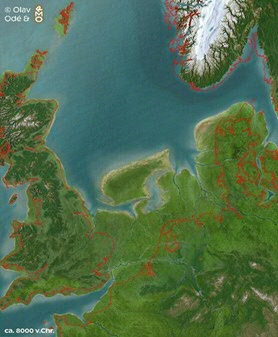Environmental change

About 20,000 years ago, the last glacial maximum came to an end. Temperatures rose progressively, albeit with major ups and downs until about 11,500 years ago, at the onset of the Holocene. The warming climate not only led to changing vegetation – polar deserts would subsequently make room for tundra/steppe, taiga and dense woodland – and fauna, but also structurally rising sea levels. As a result, the geographical situation in Doggerland changed continuously, and gradually more and more land was lost to the sea. By the time the Dogger Banks and Brown Bank formed the last islands to remain in the North Sea, about 8,200 years ago, a tsunami and a 1.5 meters sea-level ‘jump’ had sudden and abrupt impact of what was left of Doggerland. Eventually, by 7,000 years ago, the North Sea had become what it is more or less today.
Changes in the environment will be studied from various perspectives. Large numbers of animal bones, belonging to many different species of mammals, birds, reptiles and fish provide information about the composition of fauna. Radiocarbon dating of bones will anchor these in time, and when combined with models of sea-level rise, we can get an idea of how the animal world changed. Analysis of the isotopic composition of animal bones will add to this picture, providing information about animal diets. In turn, this will also help us to understand how the diet of animals that were part of the human diet, added to the isotopic fingerprint in human bones. All these factors taken together, permit to build a framework within which we can better understand how environmental change due to climate and sea-level rise affected human existence.
| Last modified: | 31 May 2021 11.16 a.m. |
